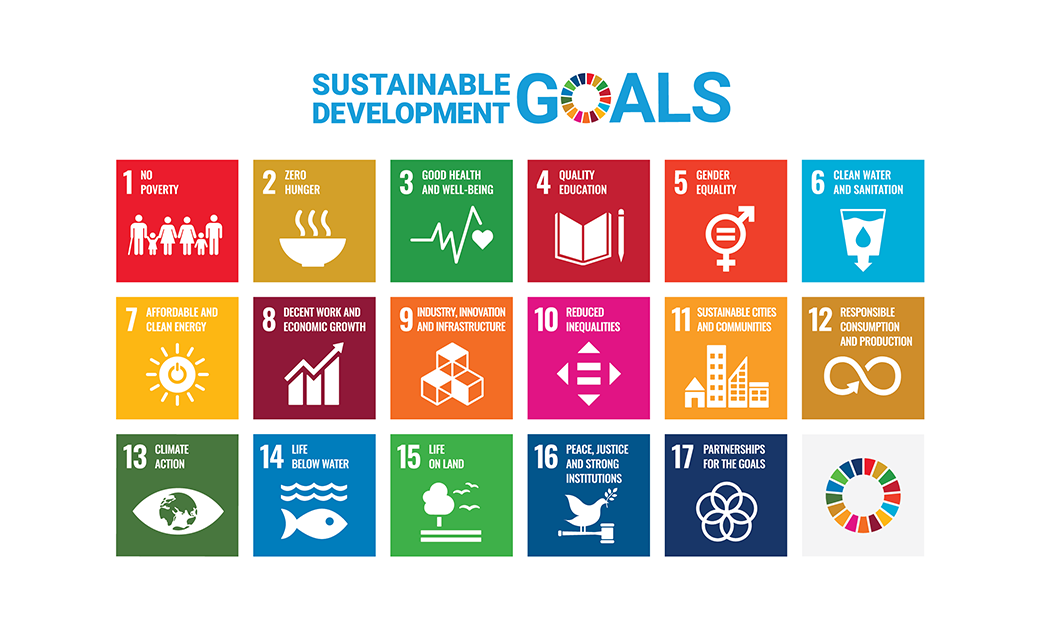What is Sustainability?
The environmental problems and poverty that accompanied rapid postwar development and progress improved people's standard of living, but at the same time brought about serious social problems such as poverty and environmental issues. Those social problems have continued to the present day without drastic solutions.
In recent years, the global movement to solve these social problems has accelerated with the spread of the word “sustainability,” and the SDGs, the international goals adopted by the UN General Assembly in September 2015, have served to clarify the direction of these activities in a concrete and clear manner and to spread them to the general public. The SDGs have now become the standard for “sustainable” and “sustainability.” The words “sustainable,” “sustainability,” and “SDGs” are now so widespread that it is no exaggeration to say that they are a universal language.
However, even if you are familiar with the term itself and have a vague understanding of it, few people may be able to explain what each term refers to and how it differs from each other. In this article, we will explain the meaning of the word "sustainability," what we should aim for, and the differences between "sustainability" and "SDGs," which are often confused with each other.

The History and Evolution of “Sustainability”
What does “sustainability” mean in the first place? First, we will explain the meaning of the word, as well as the historical background of the word “sustainability.”

01 What is “sustainability?”
Sustainability is a word coined by combining “Sustain (to maintain, sustain)” and “Ability (the ability to do),” and is translated as “sustainability.” It refers to the concept of aiming for development from a medium- to long-term perspective in the midst of increasingly serious social problems such as environmental issues and poverty. Based on the idea of sustainability, countries around the world are required not only to pursue economic activities but also to consider humanity and the global environment.

02 History of "Sustainability"
Behind “sustainability” are the environmental and poverty issues associated with resource development. With the rapid economic expansion in developed countries after World War II, people's standard of living has dramatically improved. At the same time, however, serious environmental destruction and poverty in developing countries began to be discussed in international forums in the late 1960s.
The international debate on social issues began in 1972 with the International Conference on the Human Environment, the world's first international conference on environmental issues, held in Stockholm, Sweden. 1987 saw the release of “Our Common Future,” a report by the World Commission on Environment and Development. Our Common Future” was published by the World Commission on Environment and Development in 1987. In that report, the term “sustainable development,” which is the origin of the word “sustainability,” appeared. The report defined “sustainable development” as “development that satisfies the needs of the present generation while meeting the needs of future generations,” and proposed the idea that “the environment and development can coexist.”
Reference: Sustainable Development丨Ministry of Foreign Affairs of Japan
The Earth Summit held in Rio de Janeiro, Brazil in 1992 triggered the spread of this idea worldwide. This was followed by the Millennium Development Goals (MDGs), an advance on the SDGs proposed at the UN Millennium Summit in 2001, which led to the SDGs adopted by the UN in 2015.
The Difference Between “Sustainability” and “SDGs”
If we go back in the history of sustainability, we can see that the idea of “sustainability” led to the “SDGs.” However, the SDGs are not a change from, nor are they identical to, sustainability. This section explains the differences between the terms “sustainability” and “SDGs,” which are often confused.
01 What are the SDGs?
The “SDGs” are international goals that depict what should be achieved by 2030, adopted unanimously by the 193 member countries at the UN Summit in September 2015. “SDGs” stands for “Sustainable Development Goals.”

- Universality
-
Action by all countries,
including developed countries
- Inclusiveness
-
Reflecting the philosophy of human security assurance,
“no one is left behind.”
- Participle type
-
All stakeholders
have a role to play
- Integrity
-
Integrative approach to social, economic, and environmental issues
- Transparency
-
Regular follow-up
The SDGs consist of 17 goals related to “economy,” “society,” “environment,” etc., and 169 targets that show specific efforts to achieve them, and serve as guidelines for governments and businesses to work toward.
02 The Difference Between “Sustainability” and “SDGs”
Sustainability” has become a concept to realize a society where the environment, society, and economy can develop sustainably in light of the problems brought about by development and progress. In other words, it is a “concept” for achieving a sustainable society.
The SDGs, on the other hand, are specific international goals and action guidelines for achieving sustainability based on the above-mentioned concept of sustainability. The difference is that the SDGs have a 2030 deadline for achievement, while sustainability is a long-term commitment with no set deadline.

Benefits of Corporate Sustainability Initiatives
Sustainability efforts are required of each and every person living on our planet, but companies are expected to play a particularly important role in terms of their impact on the environment and society. The human and financial resources of companies are also an important factor in achieving sustainability.
From a different perspective, however, sustainability efforts are also important for the sustainability of the company itself.
From here, we will explain the benefits to a company of engaging in sustainability.

01 Enhancing Corporate Value and Competitiveness
The adoption of the SDGs has also served to spread the importance of sustainability to the general public. This has also had a significant impact on consumers' value judgments, and in recent years, the perspectives of “sustainability” and “SDGs” have become important reasons for consumers to choose products and services. Sustainability is a reason for consumers to choose a company, and it can lead to increased competitiveness in the marketplace.
It is also important for companies to demonstrate their commitment to sustainability in order to gain the trust of stakeholders, such as business partners, shareholders, and investors, as well as consumers. As will be discussed later, companies that are committed to ESG initiatives will also have an advantage in terms of fundraising. A company that not only pursues its own profit but also seeks to solve social issues through its business will be able to increase its social value.

02
Strengthening Employee Engagement
and Attracting Top Talent
A company's sustainability efforts include not only those that address society in general, but also those that improve its own employment and working environment, such as “employment,” “diversity,” and “occupational health and safety. Creating a good working environment as part of sustainability efforts will not only increase employee satisfaction, but will also be advantageous in terms of recruitment.
In addition, as interest in social issues grows, employees and job seekers alike are increasingly concerned about the social significance of a company's business activities. A company's commitment to sustainability is a key factor in enhancing employee engagement and attracting top talent.

03 New Business Opportunities
Sustainability initiatives have been attracting increasing attention in the wake of the SDGs, and sustainability-related business expansion is expected worldwide. In other words, sustainability is also a new business opportunity for companies.
Sustainability and the SDGs are a universal language, so business development based on sustainability and the SDGs will also play a role in communicating the company's business on a global scale. This will increase the potential for collaboration with new companies, thereby broadening the scope and increasing the influence of your company.
Related Terms for Sustainability in the Enterprise
As corporate sustainability initiatives have gained importance, many terms related to them have been created.
In particular, the common terms “CSR,” “CSV,” and “ESG” will be explained.
01 CSR (Corporate Social Responsibility)
CSR stands for corporate social responsibility.
A company has many stakeholders, including customers, employees, business partners, and investors. The larger the company, the more stakeholders it has, and the greater its social influence. CSR has the meaning of fulfilling social responsibilities to such stakeholders through social contribution activities. For this reason, it is often used synonymously with “social contribution activities” conducted by companies in general.
In terms of activities that create social value without pursuing only profits for the company, CSR is included in sustainability in a broad sense. However, there is a major difference between the two in that sustainability is focused on a wide range of activities that are included in “society,” while CSR is focused on “companies” whose objective is to ensure their survival by fulfilling their social responsibilities.

02 CSV (Creating Shared Value)
CSV stands for Creating Shared Value. It refers to the concept of increasing a company's competitiveness by balancing “social value,” meaning the resolution of social issues and contribution to society, and “economic value,” meaning economic value and profit.
While CSR is usually conducted as a social contribution activity separate from the original business, CSV is characterized by the concept of gaining “economic value” through the realization of “social value” and is viewed as part of corporate strategy.

03 ESG
ESG is an acronym for Environment, Social, and Governance. A management method that emphasizes these three elements, which are essential for a company's long-term growth, is called “ESG management,” and was originally considered an evaluation indicator for investment. Today, “ESG” is not limited to investment, but is considered important as a guideline for increasing corporate value.
Like CSR, ESG is a concept based on the social value of sustainability. However, ESG is based on investment, and the starting point is “how a company should be” in order to be evaluated by investors. ESG is being addressed as a specialized task.
Key Points for Corporate Sustainability Initiatives
Corporate sustainability efforts are attracting worldwide attention, but what should companies pay attention to when they are working on sustainability in the future? Here we introduce some key points for corporate sustainability promotion.

01 Clarify “Purpose” and “Measures”
As explained in “The Difference and Relationship between ‘Sustainability’ and ‘SDGs,’” sustainability refers to the concept of realizing a sustainable society, and the SDGs refer to goals and action guidelines based on this concept. In terms of corporate activities, sustainability is a company's “purpose” (meaning of existence), and the SDGs are the goals for achieving this purpose.
Companies need to consider how their corporate activities can provide value based on sustainability as their “Purpose.” The goals and targets of the SDGs will serve as a guideline when considering what specific measures to take. However, the SDGs aim to solve basic problems common to all countries and are not unique in themselves, so if you get too caught up in the SDGs themselves, you may end up with superficial measures that do not fit your company's actual situation. Therefore, the SDGs should be considered only as a guideline, and the company should consider its own unique measures based on its own perspectives.

02 Set goals from a long-term perspective
Sustainability initiatives do not necessarily lead directly to profits, nor can they be expected to produce short-term results. However, building long-term relationships of trust with consumers and stakeholders through sustainability initiatives and responding to their demands will lead to the long-term enhancement of a company's value. In addition, non-financial value is also an important aspect of corporate activities due to the focus on ESG investment.
Instead of making business decisions based on a lack of short-term returns, be sure to set goals from a long-term perspective, with an eye on the future of society and the company.

03
Sustainability Transformation (SX)
Awareness and Initiatives
The broad concept of “sustainability” includes the sustainability of the company itself. As mentioned above, “social value” and “economic value” are not trade-offs. It could be said that a company can create social value only by earning profits and continuing its business.
The broad concept of “sustainability” includes the sustainability of the company itself. As mentioned above, “social value” and “economic value” are not trade-offs. It could be said that a company can create social value only by earning profits and continuing its business.

03
Disclosing Sustainability Initiatives
Internally and Externally
Sustainability efforts as a company contribute to the enhancement of value both internally and externally. In particular, it is important to promote the concept of sustainability and raise awareness of the concept through workshops and other means, as the actions of not only management but also employees are important within the company. This is expected to lead to further strengthening of employee engagement.
It is also important to communicate these efforts to the outside world. Proactive efforts toward sustainability are expected to lead to increased trust and recognition from stakeholders. In particular, as symbolized by ESG investment, initiatives with high social value are likely to have a direct impact on business continuity, including fund procurement from investors.
Another key point is that it will be easier to collaborate with other companies and institutions under the watchwords of sustainability and the SDGs. Creating opportunities for collaboration by communicating attractive initiatives will lead to business development as a company.
Examples of Corporate Sustainability Initiatives
From here, we will introduce examples of various companies that actually engage in sustainability.

01 Unilever Japan K.K.
Unilever, one of the world's leading manufacturers of general merchandise, has been committed to sustainability since 2010, when it introduced the Unilever Sustainable Living Plan, in line with its mission of “making sustainability a normal part of our daily lives.” Unilever is a pioneer in the field of sustainability.
In 2021, Unilever Compass, the successor to the Unilever Sustainable Living Plan, was announced. In it, the company's new vision is to “become a global leader in sustainable business.” It sets out specific goals and policies with approximately 30 numerical targets in three areas: “improving the health of the planet,” “improving the health, confidence, and wellbeing of people,” and “contributing to a fairer, more socially inclusive world.”

02 Starbucks Coffee Japan, Ltd.
Coffee chain Starbucks is well known for its many progressive sustainability initiatives. With its “Resource Positive” vision of giving back more than it gets from the earth, the company has set clear reduction targets in three areas: water use, carbon dioxide emissions, and waste emissions.
As part of Resource Positive, the company has developed “Greener Stores,” which have acquired the international Greener Stores Framework certification for environmentally friendly stores. The Greener Stores Framework is a standard jointly developed by Starbucks and the World Wide Fund for Nature (WWF) to help stores reduce their environmental impact by reducing water consumption, carbon dioxide, and waste. Starbucks aims to open 10,000 Greener Stores worldwide by 2025.

03 FAST RETAILING CO., LTD.
Fast Retailing, which develops apparel brands such as UNIQLO, has adopted a sustainability statement, “The power of clothing is the power of society.” In 2021, the company established targets and action plans for 2030 in key areas of sustainability. In 2021, the company established targets and action plans for 2030 in key areas of sustainability, including a goal to reduce greenhouse gas emissions not only by the company itself but also by its supply chain, and a clear policy to achieve this goal, such as switching to recycled materials for approximately 50% of all materials used by 2030.
In addition to the environmental aspect, the company is promoting multifaceted sustainability initiatives, such as donating clothing to refugees and creating a diversity-conscious work environment.

04 Nestlé
Nestlé, one of the world's leading food manufacturers, has implemented a medium- to long-term plan with the long-term goal of 2030: to achieve virtually zero greenhouse gas emissions by 2050, using 100% renewable electricity and reducing food loss.
We have also set a commitment to make all packaging produced worldwide recyclable and reusable by 2025. In fact, we began switching to paper packaging for various products in 2019. From the start of the initiative to the end of 2022, we have succeeded in reducing plastic by a cumulative total of 1,150 tons.
Finally
Sustainability and the SDGs are common concepts around the world and something everyone needs to address. However, when we look at actual corporate initiatives, they vary widely. Each company needs to balance social value and economic value based on its own resources and strong points.
Conversely, sustainability initiatives as a company can be seen as an opportunity to create new value. Sustainability initiatives will also lead to sustainable corporate growth, such as increased corporate value and fundraising.
Our company, Circular Economy.TOKYO Co., Ltd is a learning platform that provides new knowledge and learning about sustainability in various forms. Please contact us to discuss how we can help you introduce sustainability initiatives.






